BMP6002 - Strategic Management: VRIO & Porter's Five Forces on Cadbury
VerifiedAdded on 2023/06/07
|5
|1745
|155
Essay
AI Summary
This essay provides an analysis of strategic management concepts, comparing prescriptive and emergent approaches to strategy development. It delves into the VRIO framework, applying it to Cadbury to identify valuable, rare, inimitable, and organized resources. Furthermore, the essay examines Porter's Five Forces, assessing the competitive rivalry, threat of substitutes, threat of new entrants, bargaining power of suppliers, and bargaining power of buyers in the context of Cadbury's industry. The analysis aims to provide insights into Cadbury's strategic position and the competitive dynamics of the confectionary market, emphasizing the importance of strategic tools in organizational decision-making. Desklib offers a range of solved assignments and study resources for students.
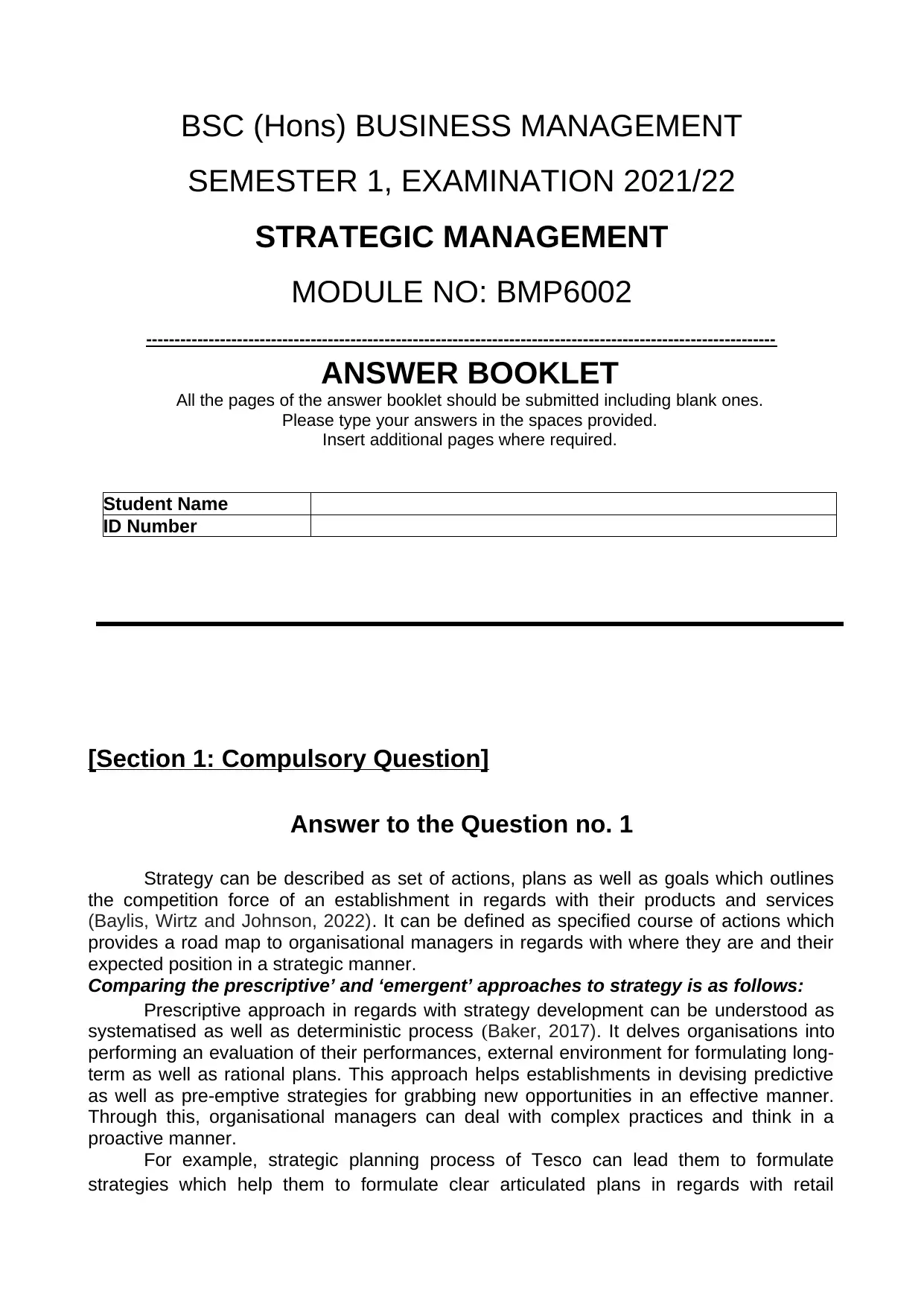
BSC (Hons) BUSINESS MANAGEMENT
SEMESTER 1, EXAMINATION 2021/22
STRATEGIC MANAGEMENT
MODULE NO: BMP6002
---------------------------------------------------------------------------------------------------------------
ANSWER BOOKLET
All the pages of the answer booklet should be submitted including blank ones.
Please type your answers in the spaces provided.
Insert additional pages where required.
Student Name
ID Number
[Section 1: Compulsory Question]
Answer to the Question no. 1
Strategy can be described as set of actions, plans as well as goals which outlines
the competition force of an establishment in regards with their products and services
(Baylis, Wirtz and Johnson, 2022). It can be defined as specified course of actions which
provides a road map to organisational managers in regards with where they are and their
expected position in a strategic manner.
Comparing the prescriptive’ and ‘emergent’ approaches to strategy is as follows:
Prescriptive approach in regards with strategy development can be understood as
systematised as well as deterministic process (Baker, 2017). It delves organisations into
performing an evaluation of their performances, external environment for formulating long-
term as well as rational plans. This approach helps establishments in devising predictive
as well as pre-emptive strategies for grabbing new opportunities in an effective manner.
Through this, organisational managers can deal with complex practices and think in a
proactive manner.
For example, strategic planning process of Tesco can lead them to formulate
strategies which help them to formulate clear articulated plans in regards with retail
SEMESTER 1, EXAMINATION 2021/22
STRATEGIC MANAGEMENT
MODULE NO: BMP6002
---------------------------------------------------------------------------------------------------------------
ANSWER BOOKLET
All the pages of the answer booklet should be submitted including blank ones.
Please type your answers in the spaces provided.
Insert additional pages where required.
Student Name
ID Number
[Section 1: Compulsory Question]
Answer to the Question no. 1
Strategy can be described as set of actions, plans as well as goals which outlines
the competition force of an establishment in regards with their products and services
(Baylis, Wirtz and Johnson, 2022). It can be defined as specified course of actions which
provides a road map to organisational managers in regards with where they are and their
expected position in a strategic manner.
Comparing the prescriptive’ and ‘emergent’ approaches to strategy is as follows:
Prescriptive approach in regards with strategy development can be understood as
systematised as well as deterministic process (Baker, 2017). It delves organisations into
performing an evaluation of their performances, external environment for formulating long-
term as well as rational plans. This approach helps establishments in devising predictive
as well as pre-emptive strategies for grabbing new opportunities in an effective manner.
Through this, organisational managers can deal with complex practices and think in a
proactive manner.
For example, strategic planning process of Tesco can lead them to formulate
strategies which help them to formulate clear articulated plans in regards with retail
Paraphrase This Document
Need a fresh take? Get an instant paraphrase of this document with our AI Paraphraser
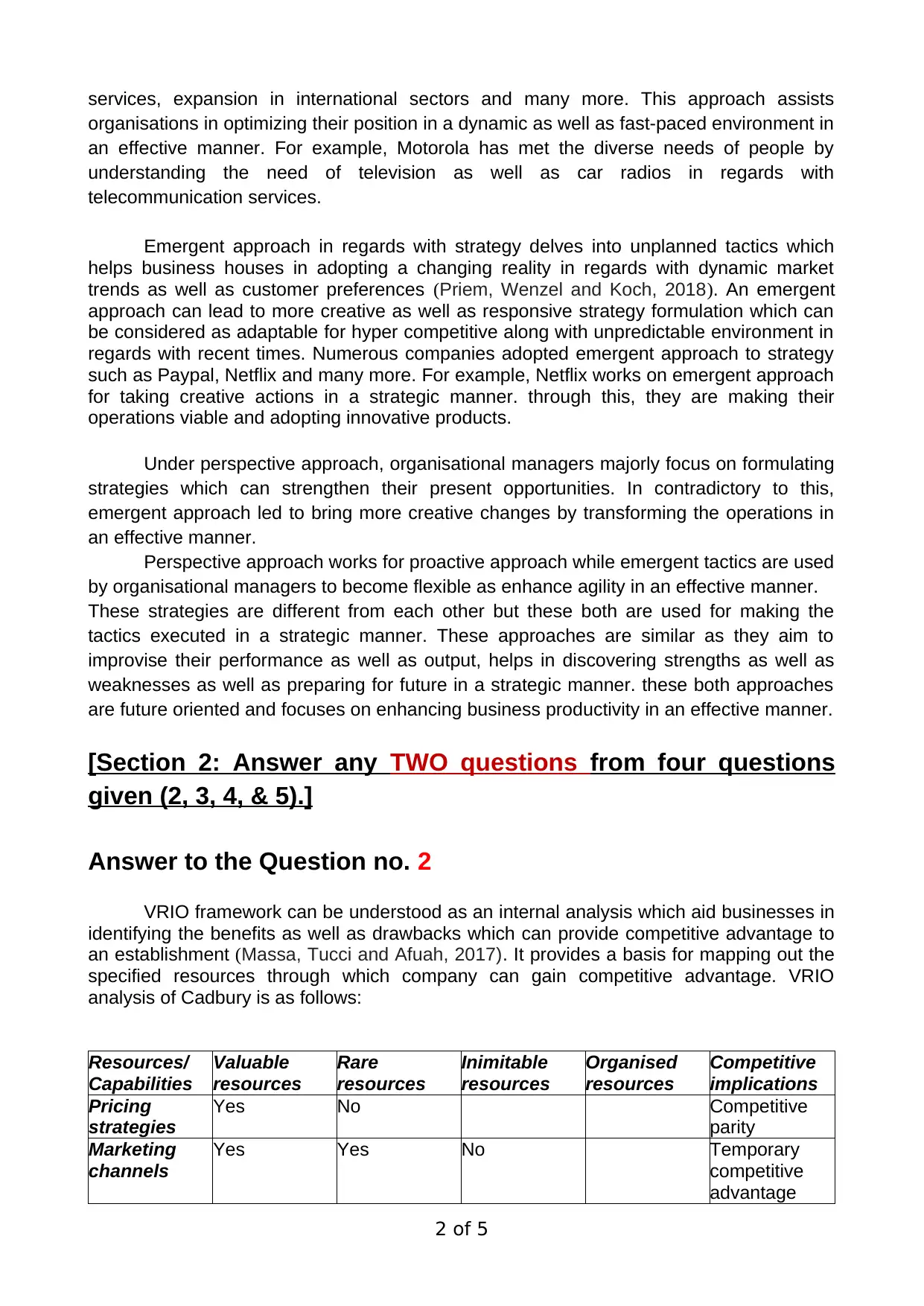
services, expansion in international sectors and many more. This approach assists
organisations in optimizing their position in a dynamic as well as fast-paced environment in
an effective manner. For example, Motorola has met the diverse needs of people by
understanding the need of television as well as car radios in regards with
telecommunication services.
Emergent approach in regards with strategy delves into unplanned tactics which
helps business houses in adopting a changing reality in regards with dynamic market
trends as well as customer preferences (Priem, Wenzel and Koch, 2018). An emergent
approach can lead to more creative as well as responsive strategy formulation which can
be considered as adaptable for hyper competitive along with unpredictable environment in
regards with recent times. Numerous companies adopted emergent approach to strategy
such as Paypal, Netflix and many more. For example, Netflix works on emergent approach
for taking creative actions in a strategic manner. through this, they are making their
operations viable and adopting innovative products.
Under perspective approach, organisational managers majorly focus on formulating
strategies which can strengthen their present opportunities. In contradictory to this,
emergent approach led to bring more creative changes by transforming the operations in
an effective manner.
Perspective approach works for proactive approach while emergent tactics are used
by organisational managers to become flexible as enhance agility in an effective manner.
These strategies are different from each other but these both are used for making the
tactics executed in a strategic manner. These approaches are similar as they aim to
improvise their performance as well as output, helps in discovering strengths as well as
weaknesses as well as preparing for future in a strategic manner. these both approaches
are future oriented and focuses on enhancing business productivity in an effective manner.
[Section 2: Answer any TWO questions from four questions
given (2, 3, 4, & 5).]
Answer to the Question no. 2
VRIO framework can be understood as an internal analysis which aid businesses in
identifying the benefits as well as drawbacks which can provide competitive advantage to
an establishment (Massa, Tucci and Afuah, 2017). It provides a basis for mapping out the
specified resources through which company can gain competitive advantage. VRIO
analysis of Cadbury is as follows:
Resources/
Capabilities
Valuable
resources
Rare
resources
Inimitable
resources
Organised
resources
Competitive
implications
Pricing
strategies
Yes No Competitive
parity
Marketing
channels
Yes Yes No Temporary
competitive
advantage
2 of 5
organisations in optimizing their position in a dynamic as well as fast-paced environment in
an effective manner. For example, Motorola has met the diverse needs of people by
understanding the need of television as well as car radios in regards with
telecommunication services.
Emergent approach in regards with strategy delves into unplanned tactics which
helps business houses in adopting a changing reality in regards with dynamic market
trends as well as customer preferences (Priem, Wenzel and Koch, 2018). An emergent
approach can lead to more creative as well as responsive strategy formulation which can
be considered as adaptable for hyper competitive along with unpredictable environment in
regards with recent times. Numerous companies adopted emergent approach to strategy
such as Paypal, Netflix and many more. For example, Netflix works on emergent approach
for taking creative actions in a strategic manner. through this, they are making their
operations viable and adopting innovative products.
Under perspective approach, organisational managers majorly focus on formulating
strategies which can strengthen their present opportunities. In contradictory to this,
emergent approach led to bring more creative changes by transforming the operations in
an effective manner.
Perspective approach works for proactive approach while emergent tactics are used
by organisational managers to become flexible as enhance agility in an effective manner.
These strategies are different from each other but these both are used for making the
tactics executed in a strategic manner. These approaches are similar as they aim to
improvise their performance as well as output, helps in discovering strengths as well as
weaknesses as well as preparing for future in a strategic manner. these both approaches
are future oriented and focuses on enhancing business productivity in an effective manner.
[Section 2: Answer any TWO questions from four questions
given (2, 3, 4, & 5).]
Answer to the Question no. 2
VRIO framework can be understood as an internal analysis which aid businesses in
identifying the benefits as well as drawbacks which can provide competitive advantage to
an establishment (Massa, Tucci and Afuah, 2017). It provides a basis for mapping out the
specified resources through which company can gain competitive advantage. VRIO
analysis of Cadbury is as follows:
Resources/
Capabilities
Valuable
resources
Rare
resources
Inimitable
resources
Organised
resources
Competitive
implications
Pricing
strategies
Yes No Competitive
parity
Marketing
channels
Yes Yes No Temporary
competitive
advantage
2 of 5
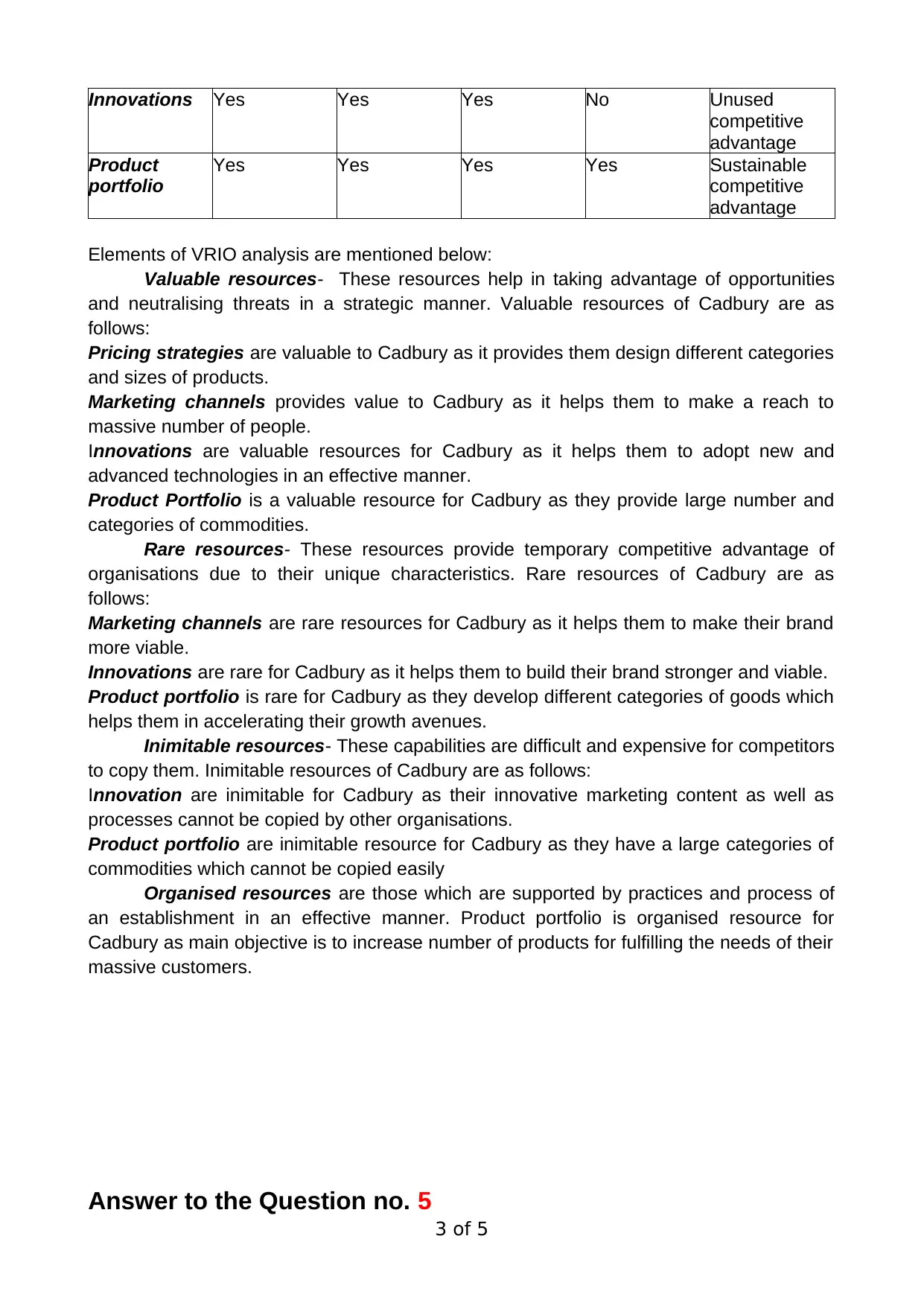
Innovations Yes Yes Yes No Unused
competitive
advantage
Product
portfolio
Yes Yes Yes Yes Sustainable
competitive
advantage
Elements of VRIO analysis are mentioned below:
Valuable resources- These resources help in taking advantage of opportunities
and neutralising threats in a strategic manner. Valuable resources of Cadbury are as
follows:
Pricing strategies are valuable to Cadbury as it provides them design different categories
and sizes of products.
Marketing channels provides value to Cadbury as it helps them to make a reach to
massive number of people.
Innovations are valuable resources for Cadbury as it helps them to adopt new and
advanced technologies in an effective manner.
Product Portfolio is a valuable resource for Cadbury as they provide large number and
categories of commodities.
Rare resources- These resources provide temporary competitive advantage of
organisations due to their unique characteristics. Rare resources of Cadbury are as
follows:
Marketing channels are rare resources for Cadbury as it helps them to make their brand
more viable.
Innovations are rare for Cadbury as it helps them to build their brand stronger and viable.
Product portfolio is rare for Cadbury as they develop different categories of goods which
helps them in accelerating their growth avenues.
Inimitable resources- These capabilities are difficult and expensive for competitors
to copy them. Inimitable resources of Cadbury are as follows:
Innovation are inimitable for Cadbury as their innovative marketing content as well as
processes cannot be copied by other organisations.
Product portfolio are inimitable resource for Cadbury as they have a large categories of
commodities which cannot be copied easily
Organised resources are those which are supported by practices and process of
an establishment in an effective manner. Product portfolio is organised resource for
Cadbury as main objective is to increase number of products for fulfilling the needs of their
massive customers.
Answer to the Question no. 5
3 of 5
competitive
advantage
Product
portfolio
Yes Yes Yes Yes Sustainable
competitive
advantage
Elements of VRIO analysis are mentioned below:
Valuable resources- These resources help in taking advantage of opportunities
and neutralising threats in a strategic manner. Valuable resources of Cadbury are as
follows:
Pricing strategies are valuable to Cadbury as it provides them design different categories
and sizes of products.
Marketing channels provides value to Cadbury as it helps them to make a reach to
massive number of people.
Innovations are valuable resources for Cadbury as it helps them to adopt new and
advanced technologies in an effective manner.
Product Portfolio is a valuable resource for Cadbury as they provide large number and
categories of commodities.
Rare resources- These resources provide temporary competitive advantage of
organisations due to their unique characteristics. Rare resources of Cadbury are as
follows:
Marketing channels are rare resources for Cadbury as it helps them to make their brand
more viable.
Innovations are rare for Cadbury as it helps them to build their brand stronger and viable.
Product portfolio is rare for Cadbury as they develop different categories of goods which
helps them in accelerating their growth avenues.
Inimitable resources- These capabilities are difficult and expensive for competitors
to copy them. Inimitable resources of Cadbury are as follows:
Innovation are inimitable for Cadbury as their innovative marketing content as well as
processes cannot be copied by other organisations.
Product portfolio are inimitable resource for Cadbury as they have a large categories of
commodities which cannot be copied easily
Organised resources are those which are supported by practices and process of
an establishment in an effective manner. Product portfolio is organised resource for
Cadbury as main objective is to increase number of products for fulfilling the needs of their
massive customers.
Answer to the Question no. 5
3 of 5
⊘ This is a preview!⊘
Do you want full access?
Subscribe today to unlock all pages.

Trusted by 1+ million students worldwide
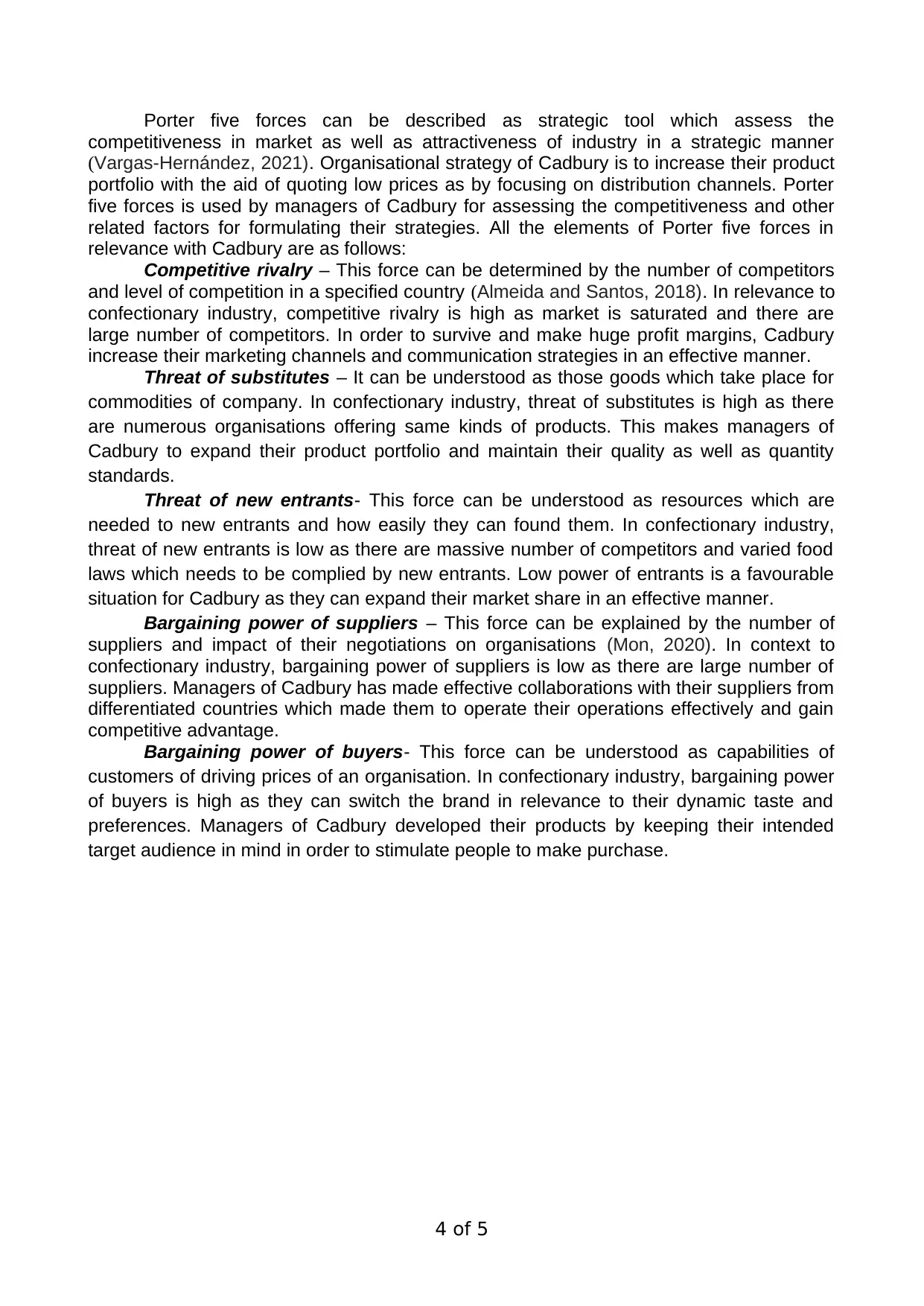
Porter five forces can be described as strategic tool which assess the
competitiveness in market as well as attractiveness of industry in a strategic manner
(Vargas-Hernández, 2021). Organisational strategy of Cadbury is to increase their product
portfolio with the aid of quoting low prices as by focusing on distribution channels. Porter
five forces is used by managers of Cadbury for assessing the competitiveness and other
related factors for formulating their strategies. All the elements of Porter five forces in
relevance with Cadbury are as follows:
Competitive rivalry – This force can be determined by the number of competitors
and level of competition in a specified country (Almeida and Santos, 2018). In relevance to
confectionary industry, competitive rivalry is high as market is saturated and there are
large number of competitors. In order to survive and make huge profit margins, Cadbury
increase their marketing channels and communication strategies in an effective manner.
Threat of substitutes – It can be understood as those goods which take place for
commodities of company. In confectionary industry, threat of substitutes is high as there
are numerous organisations offering same kinds of products. This makes managers of
Cadbury to expand their product portfolio and maintain their quality as well as quantity
standards.
Threat of new entrants- This force can be understood as resources which are
needed to new entrants and how easily they can found them. In confectionary industry,
threat of new entrants is low as there are massive number of competitors and varied food
laws which needs to be complied by new entrants. Low power of entrants is a favourable
situation for Cadbury as they can expand their market share in an effective manner.
Bargaining power of suppliers – This force can be explained by the number of
suppliers and impact of their negotiations on organisations (Mon, 2020). In context to
confectionary industry, bargaining power of suppliers is low as there are large number of
suppliers. Managers of Cadbury has made effective collaborations with their suppliers from
differentiated countries which made them to operate their operations effectively and gain
competitive advantage.
Bargaining power of buyers- This force can be understood as capabilities of
customers of driving prices of an organisation. In confectionary industry, bargaining power
of buyers is high as they can switch the brand in relevance to their dynamic taste and
preferences. Managers of Cadbury developed their products by keeping their intended
target audience in mind in order to stimulate people to make purchase.
4 of 5
competitiveness in market as well as attractiveness of industry in a strategic manner
(Vargas-Hernández, 2021). Organisational strategy of Cadbury is to increase their product
portfolio with the aid of quoting low prices as by focusing on distribution channels. Porter
five forces is used by managers of Cadbury for assessing the competitiveness and other
related factors for formulating their strategies. All the elements of Porter five forces in
relevance with Cadbury are as follows:
Competitive rivalry – This force can be determined by the number of competitors
and level of competition in a specified country (Almeida and Santos, 2018). In relevance to
confectionary industry, competitive rivalry is high as market is saturated and there are
large number of competitors. In order to survive and make huge profit margins, Cadbury
increase their marketing channels and communication strategies in an effective manner.
Threat of substitutes – It can be understood as those goods which take place for
commodities of company. In confectionary industry, threat of substitutes is high as there
are numerous organisations offering same kinds of products. This makes managers of
Cadbury to expand their product portfolio and maintain their quality as well as quantity
standards.
Threat of new entrants- This force can be understood as resources which are
needed to new entrants and how easily they can found them. In confectionary industry,
threat of new entrants is low as there are massive number of competitors and varied food
laws which needs to be complied by new entrants. Low power of entrants is a favourable
situation for Cadbury as they can expand their market share in an effective manner.
Bargaining power of suppliers – This force can be explained by the number of
suppliers and impact of their negotiations on organisations (Mon, 2020). In context to
confectionary industry, bargaining power of suppliers is low as there are large number of
suppliers. Managers of Cadbury has made effective collaborations with their suppliers from
differentiated countries which made them to operate their operations effectively and gain
competitive advantage.
Bargaining power of buyers- This force can be understood as capabilities of
customers of driving prices of an organisation. In confectionary industry, bargaining power
of buyers is high as they can switch the brand in relevance to their dynamic taste and
preferences. Managers of Cadbury developed their products by keeping their intended
target audience in mind in order to stimulate people to make purchase.
4 of 5
Paraphrase This Document
Need a fresh take? Get an instant paraphrase of this document with our AI Paraphraser
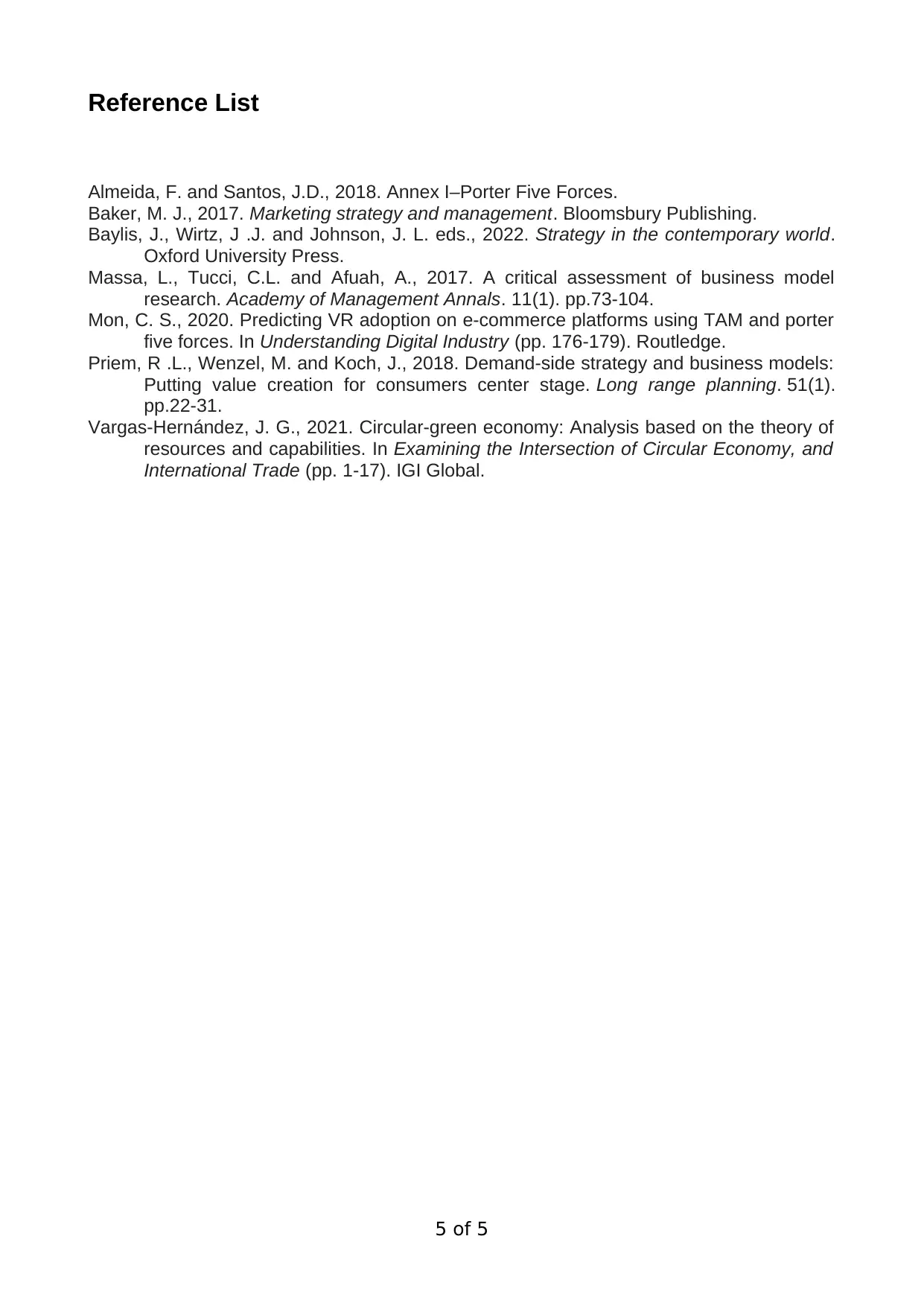
Reference List
Almeida, F. and Santos, J.D., 2018. Annex I–Porter Five Forces.
Baker, M. J., 2017. Marketing strategy and management. Bloomsbury Publishing.
Baylis, J., Wirtz, J .J. and Johnson, J. L. eds., 2022. Strategy in the contemporary world.
Oxford University Press.
Massa, L., Tucci, C.L. and Afuah, A., 2017. A critical assessment of business model
research. Academy of Management Annals. 11(1). pp.73-104.
Mon, C. S., 2020. Predicting VR adoption on e-commerce platforms using TAM and porter
five forces. In Understanding Digital Industry (pp. 176-179). Routledge.
Priem, R .L., Wenzel, M. and Koch, J., 2018. Demand-side strategy and business models:
Putting value creation for consumers center stage. Long range planning. 51(1).
pp.22-31.
Vargas-Hernández, J. G., 2021. Circular-green economy: Analysis based on the theory of
resources and capabilities. In Examining the Intersection of Circular Economy, and
International Trade (pp. 1-17). IGI Global.
5 of 5
Almeida, F. and Santos, J.D., 2018. Annex I–Porter Five Forces.
Baker, M. J., 2017. Marketing strategy and management. Bloomsbury Publishing.
Baylis, J., Wirtz, J .J. and Johnson, J. L. eds., 2022. Strategy in the contemporary world.
Oxford University Press.
Massa, L., Tucci, C.L. and Afuah, A., 2017. A critical assessment of business model
research. Academy of Management Annals. 11(1). pp.73-104.
Mon, C. S., 2020. Predicting VR adoption on e-commerce platforms using TAM and porter
five forces. In Understanding Digital Industry (pp. 176-179). Routledge.
Priem, R .L., Wenzel, M. and Koch, J., 2018. Demand-side strategy and business models:
Putting value creation for consumers center stage. Long range planning. 51(1).
pp.22-31.
Vargas-Hernández, J. G., 2021. Circular-green economy: Analysis based on the theory of
resources and capabilities. In Examining the Intersection of Circular Economy, and
International Trade (pp. 1-17). IGI Global.
5 of 5
1 out of 5
Related Documents
Your All-in-One AI-Powered Toolkit for Academic Success.
+13062052269
info@desklib.com
Available 24*7 on WhatsApp / Email
![[object Object]](/_next/static/media/star-bottom.7253800d.svg)
Unlock your academic potential
Copyright © 2020–2025 A2Z Services. All Rights Reserved. Developed and managed by ZUCOL.




